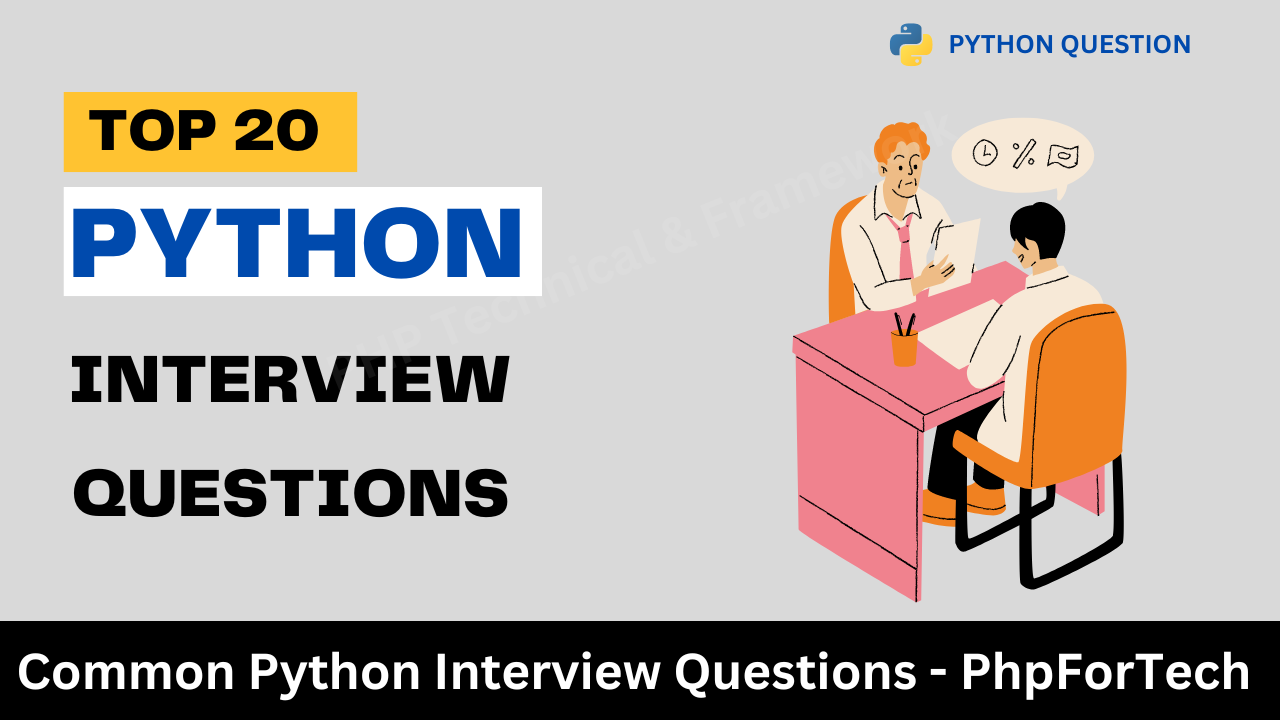Common Python Interview Questions – PhpForTech
Python is a popular and versatile programming language known for its simplicity, readability, and extensive range of applications. It has gained widespread adoption in various domains, including web development, data analysis, machine learning, and automation. Python’s beginner-friendly syntax and vast ecosystem of libraries and frameworks make it an attractive choice for both beginners and experienced developers. In this section, we will explore a few Python interview questions and their answers to help you prepare for your Python interviews.
Q1. What is Python?
Answer: Python is a high-level, interpreted programming language known for its simplicity and readability. It emphasizes code readability and supports multiple programming paradigms, including procedural, object-oriented, and functional programming.
Q2. What is PEP 8?
Answer: PEP 8 is the official style guide for Python code. It provides guidelines on how to format Python code to enhance its readability and maintainability.
Q3. How do you comment in Python?
Answer: In Python, you can use the hash symbol (#) to add comments. Anything after the hash symbol on a line is considered a comment and is not executed as code.
Q4. What is the difference between a list and a tuple in Python?
Answer: A list is a mutable sequence of elements enclosed in square brackets ([]), while a tuple is an immutable sequence enclosed in parentheses (()). This means that you can modify a list (add, remove, or modify elements), but you cannot modify a tuple once it is created.
Q5. What is the difference between ‘==’ and ‘is’ in Python?
Answer: The ‘==’ operator checks for equality, i.e., if the values of two objects are the same. The ‘is’ operator checks for identity, i.e., if two objects refer to the same memory location.
Q6. What is the difference between a shallow copy and a deep copy?
Answer: A shallow copy creates a new object that references the same memory as the original object. A deep copy creates a new object and recursively copies all the nested objects, so the new object is completely independent of the original one.
Q7. How do you handle exceptions in Python?
Answer: Exceptions can be handled using try-except blocks. Code that may raise an exception is placed inside the try block, and the except block handles the exception if it occurs.
Q8. What is the purpose of the “if name == ‘main‘:” statement?
Answer: This statement allows a module to be both imported and executed directly. The code inside the if block will only run if the module is executed as the main program and not when it is imported by another module.
Q9. What is a decorator in Python?
Answer: A decorator is a design pattern in Python that allows the modification of a function or a class using another function. It is represented by the ‘@’ symbol followed by the decorator function name, placed before the function or class definition.
Q10. What is a generator in Python?
Answer: A generator is a type of iterator that generates values on the fly, instead of storing them all in memory. It is created using a function that contains the ‘yield’ keyword, and it generates values one at a time when iterated.
Q11. What is the difference between ‘range’ and ‘xrange’ in Python 2?
Answer: In Python 2, ‘range’ creates a list containing all the values, while ‘xrange’ returns an object that generates the values on the fly. ‘xrange’ is more memory-efficient for large ranges.
Q12. What is a lambda function in Python?
Answer: A lambda function is an anonymous function defined using the lambda keyword. It can take any number of arguments but can only have one expression. Lambda functions are commonly used in functional programming.
Q13. What is the difference between ‘append’ and ‘extend’ in Python lists?
Answer: The ‘append’ method adds an element to the end of a list, while the ‘extend’ method extends a list by appending elements from another iterable.
Q14. How do you open and close a file in Python?
Answer: You can open a file using the ‘open’ function, specifying the file path and the mode (e.g., ‘r’ for reading, ‘w’ for writing). To close the file, you can use the ‘close’ method of the file object or use the ‘with’ statement, which automatically closes the file when done.
Q15. What is the difference between ‘read()’ and ‘readlines()’ methods for file handling?
Answer: The ‘read()’ method reads the entire file and returns its contents as a string, while the ‘readlines()’ method reads the file line by line and returns a list of strings, with each string representing a line.
Q16. How do you remove duplicates from a list in Python?
Answer: You can remove duplicates from a list by converting it to a set using the ‘set()’ function and then converting it back to a list using the ‘list()’ function.
Q17. How do you reverse a string in Python?
Answer: You can reverse a string using slicing. For example, if ‘s’ is a string, you can reverse it by using ‘s[::-1]’.
Q18. What is a module in Python?
Answer: A module in Python is a file containing Python definitions and statements. It can be used to organize related code into separate files and can be imported into other Python programs.
Q19. What is the difference between ‘staticmethod’ and ‘classmethod’?
Answer: A ‘staticmethod’ is a method that belongs to a class but does not have access to the instance or class itself. A ‘classmethod’ is a method that has access to the class and can modify class-level attributes.
Q20. How do you install third-party packages in Python?
Answer: You can install third-party packages in Python using the package manager called pip. Open the command line or terminal and use the command ‘pip install <package_name>’ to install a package.
These questions cover various fundamental concepts in Python and can help you prepare for a beginner-level interview. Good luck and happy coding!
